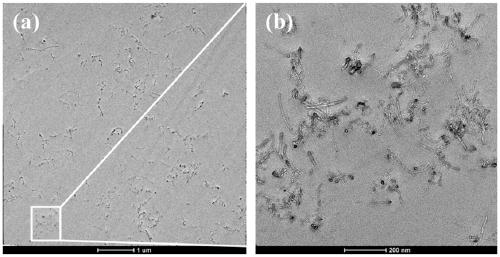Tung oil-based epoxy resin composite material and preparation method thereof
A technology based on epoxy resin and composite materials, which is applied in the field of tung oil-based epoxy resin composite materials and its preparation, can solve the problems of poor antistatic effect, poor impact resistance, lack of flexibility, etc., and achieve high elongation at break, Inexpensive, wide-ranging effects
- Summary
- Abstract
- Description
- Claims
- Application Information
AI Technical Summary
Problems solved by technology
Method used
Image
Examples
Embodiment 1
[0020] Step 1, tung oil fatty acid methyl ester (1.00g), fumaric acid (0.35g) and acetic acid (1.75g) were added into the flask and then refluxed for 48h. After recovering acetic acid with a rotary evaporator under vacuum, dichloromethane was added dropwise to the reaction residue to precipitate excess fumaric acid and filtered, and the filtrate was vacuum evaporated with a rotary evaporator to obtain a crude product; 129g of the crude product was dissolved in 500mL In acetone, add 50wt.% sodium hydroxide solution dropwise to neutralize to pH 7, after removing acetone, add 100mL n-hexane and 400mL water to separate unreacted fatty acid methyl ester. The aqueous layer was saponified with excess sodium hydroxide and then acidified with 1M hydrochloric acid solution. The separated tribasic acid was extracted with ethyl acetate. After the organic layer was washed with water, anhydrous Na was added 2 SO 4 Dry for 12 hours, remove ethyl acetate with a vacuum rotary evaporator to ...
Embodiment 2
[0025]Step 1, tung oil fatty acid methyl ester (1.00g), acrylic acid (0.20g) and acetic acid (1.75g) were added into the flask and then refluxed for 48h. After the acetic acid was recovered with a rotary evaporator under vacuum, dichloromethane was added dropwise to the reaction residue to precipitate excess acrylic acid and filtered, and the filtrate was vacuum evaporated with a rotary evaporator to obtain a crude product; 129g of the crude product was dissolved in 500mL of acetone , Add 50wt.% sodium hydroxide solution dropwise to neutralize to pH 7, remove acetone, add 100mL n-hexane and 400mL water to separate unreacted fatty acid methyl ester. The aqueous layer was saponified with excess sodium hydroxide and then acidified with 1M hydrochloric acid solution. The precipitated dibasic acid was extracted with ethyl acetate. After the organic layer was washed with water, anhydrous Na was added 2 SO 4 Dry for 12 hours, remove ethyl acetate with a vacuum rotary evaporator to...
Embodiment 3
[0030] Step 1, tung oil fatty acid methyl ester (1.00g), fumaric acid (0.35g) and acetic acid (1.75g) were added into the flask and then refluxed for 48h. After recovering acetic acid with a rotary evaporator under vacuum, dichloromethane was added dropwise to the reaction residue to precipitate excess fumaric acid and filtered, and the filtrate was vacuum evaporated with a rotary evaporator to obtain a crude product; 129g of the crude product was dissolved in 500mL In acetone, add 50wt.% sodium hydroxide solution dropwise to neutralize to pH 7, after removing acetone, add 100mL n-hexane and 400mL water to separate unreacted fatty acid methyl ester. The aqueous layer was saponified with excess sodium hydroxide and then acidified with 1M hydrochloric acid solution. The separated tribasic acid was extracted with ethyl acetate. After the organic layer was washed with water, anhydrous Na was added 2 SO 4 Dry for 12 hours, remove ethyl acetate with a vacuum rotary evaporator to ...
PUM
 Login to view more
Login to view more Abstract
Description
Claims
Application Information
 Login to view more
Login to view more - R&D Engineer
- R&D Manager
- IP Professional
- Industry Leading Data Capabilities
- Powerful AI technology
- Patent DNA Extraction
Browse by: Latest US Patents, China's latest patents, Technical Efficacy Thesaurus, Application Domain, Technology Topic.
© 2024 PatSnap. All rights reserved.Legal|Privacy policy|Modern Slavery Act Transparency Statement|Sitemap



